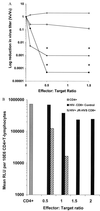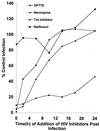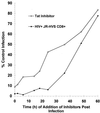CD8+ T cell-mediated suppressive activity inhibits HIV-1 after virus entry with kinetics indicating effects on virus gene expression
- PMID: 10725407
- PMCID: PMC16269
- DOI: 10.1073/pnas.97.7.3503
CD8+ T cell-mediated suppressive activity inhibits HIV-1 after virus entry with kinetics indicating effects on virus gene expression
Abstract
Individuals infected with HIV-1 have varying rates of progression to AIDS. Cellular immune responses, comprised of cytolytic and noncytolytic CD8(+) T cell effector functions, are considered important for controlling viremia and maintaining the clinically asymptomatic state. Although there is general agreement regarding CD8(+) T lymphocyte cytotoxic functions, considerable controversy exists over the nature of the noncytolytic antiviral activity of CD8(+) cells. The discovery that RANTES (regulated on activation, normal T cell expressed and secreted), MIP-1alpha, and MIP-1beta (macrophage inflammatory protein 1 alpha and beta) could inhibit HIV-1 replication by blocking viral entry processes led to the notion that these molecules are responsible for the CD8(+) cell suppressive activity. However, T tropic HIV isolates requiring the CXCR4 coreceptor for entry are insensitive to the antiviral effects of these beta-chemokines. Using a CXCR4-dependent virus, we determined that the mechanism of CD8(+) T cell-mediated activity did act after viral entry into the host cell. We also define the kinetics of the HIV life cycle in primary activated human CD4(+)-enriched T cells by using an HIV-1 reporter virus system pseudotyped with the CXCR4-dependent HIV-1 envelope gene of NL4-3. Analysis of these kinetic data indicates that CD8(+) T cell-mediated suppressive activity acts at a stage in the viral life cycle after entry and independently of the HIV envelope. Additionally, we show that the antiviral activity targets stages of the virus life cycle correlating with transcription and early proviral gene expression. These findings not only provide a range of possible targets for the CD8(+) T cell-mediated activity but also support the notion that this antiviral activity is multifactorial in nature.
Figures





References
-
- Maddon P J, Dalgleish A G, McDougal J S, Clapham P R, Weiss R A, Axel R. Cell. 1986;47:333–348. - PubMed
-
- Moore J P, Trkola A, Dragic T. Curr Opin Immunol. 1997;9:551–562. - PubMed
-
- Berger E A. AIDS. 1997;11:S3–S16. - PubMed
-
- Wyatt R, Sodroski J. Science. 1998;280:1884–1888. - PubMed
-
- Berger E A, Doms R W, Fenyo E M, Korber B T, Littman D R, Moore J P, Sattentau Q J, Schuitemaker H, Sodroski J, Weiss R A. Nature (London) 1998;391:240. - PubMed
Publication types
MeSH terms
Substances
Grants and funding
LinkOut - more resources
Full Text Sources
Other Literature Sources
Medical
Research Materials

